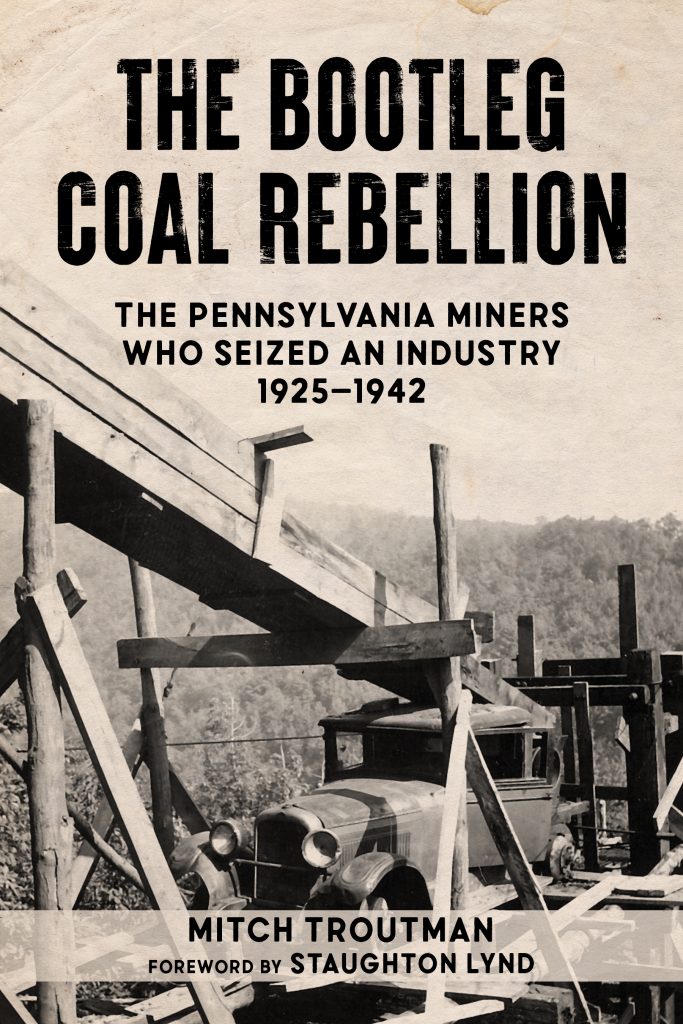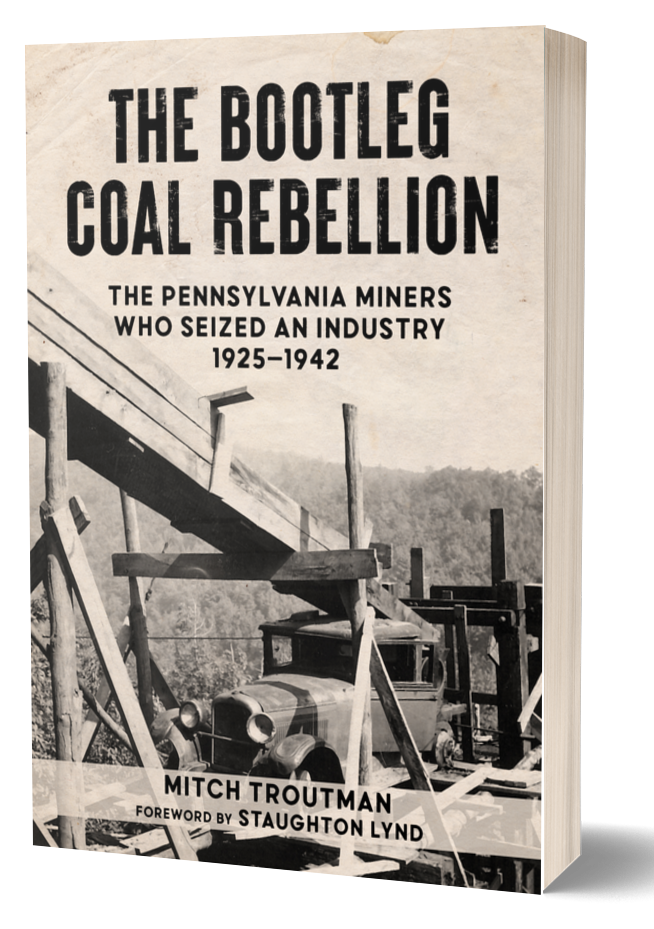By Lou Martin
Journal of Appalachian Studies 29.2
In The Bootleg Coal Rebellion: The Pennsylvania Miners Who Seized an Industry, 1925–1942, Mitch Troutman recovers the hidden history of miners who, facing mine shutdowns and growing unemployment, continued to illegally mine and sell coal using improvised methods. The book opens
with a foreword by the late Staughton Lynd who, during his career, wrote extensively about grassroots workers’ movements that were often at odds with established unions, which nicely frames major issues that Troutman explores in the rest of the book. Troutman relies on a few dozen interviews conducted in the 1990s by sociologist Michael Kozura, whose father had been involved in the bootleg coal industry. Troutman also pieces together the history of this widespread but illegal activity that occurred in eastern
Pennsylvania over two decades, using extensively researched newspapers and government documents.
Bootleg mining had its roots in common practices like digging coal out of company refuse piles or nearby outcroppings to use for home heating. During the Long Strike of 1925, miners harvested coal from idled underground and surface mines, and as more and more anthracite mines were idled for financial reasons, miners and their family members began more audacious methods. They bored shafts just wide enough for one person to go twenty to even one hundred feet down into a coal seam. A helper at the top of the “coal hole” would winch buckets of coal back to the surface. During the Great Depression, bootlegging coal became so commonplace that many local governments tolerated it. In 1936, a Pennsylvania state commission found that there were some thirteen thousand people engaged
in the bootleg coal industry, including miners with their own coal holes, independent truckers who sold the coal in places like Philadelphia and Baltimore, and breakers who constructed their own machines to pulverize the coal to different sizes.
Troutman charts the rise of this movement, which emerged as an organic response to economic conditions, and he also explores its political implications and organizational dynamics. Communist Party organizers saw potential in a movement that prioritized human rights above property rights, and some worked to organize Unemployed Councils to petition for government aid and suspend evictions. When Pennsylvania legislators introduced a bill to require truckers to carry receipts, which threatened the whole bootleg industry, thousands formed the Independent Miners’ Association and successfully lobbied against it. Regardless of formal organizations, Troutman emphasizes that bootleg miners were not radicalized by organizers and had an ideology “rooted in their own history, traditions, and circumstances” (4). The United Mine Workers of America (UMWA) looms large in The Bootleg Coal Rebellion as does its president, John L. Lewis. To end the 1925 strike, Lewis agreed to a five-year contract that offered little to the strikers. When the Depression came, anthracite miners called for a policy of “equalization,” meaning to spread work among all miners, and hoped such a policy might be written into the National Recovery Administration (NRA) codes, but Lewis, who had a seat on the NRA board, opposed it. Lewis also opposed wildcat strikes in the anthracite region, focused organizing efforts on bituminous miners, and seemingly abandoned the anthracite miners. The bootlegging of coal declined sharply during World War II as defense industries drew many of the unemployed to major cities, beginning an out-migration from the anthracite fields. Even as the US population grew between 1940 and 1960, these coal counties lost about a quarter of their population, and the decline continued in the following decades. Troutman has painstakingly reconstructed the history of a movement that left no official records. He also paints a richly textured and loving portrait of the area and its communities like Shamokin, Minersville, and Mahanoy City. Writing in a conversational tone, he captures the pride of
the bootleg miners as they improvised machinery, risked their lives, and broke laws to feed their families. He also captures their bitterness as they felt abandoned by companies, the government, and the union. At times, Troutman leaves out context that could have made Lewis and other UMW leaders seem less capricious, but he succeeds in recovering a history that had largely been lost.
Students of Appalachian history will be interested to learn about the UMW’s legacy in the anthracite fields, community responses to mine shutdowns, and events that preceded mass out-migration. While most of the places Troutman discusses are within Appalachia as defined by the Appalachian Regional Commission, their history is often overlooked, but the book’s themes will be quite familiar.
Lou Martin is Associate Professor of History at Chatham University, author of Smokestacks in the Hills: Rural-Industrial Workers in West Virginia (2015), and a founding board member of the West Virginia Mine Wars Museum. His great-grandfather, Lajos Martón, was a coal miner in Beech Bottom, West Virginia, before becoming a bootlegger—in the common usage—meaning he sold beer during Prohibition.






